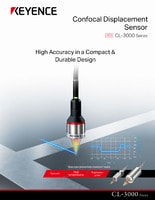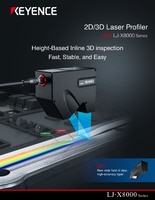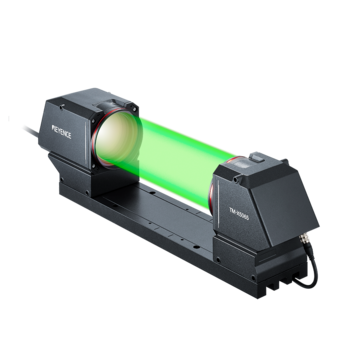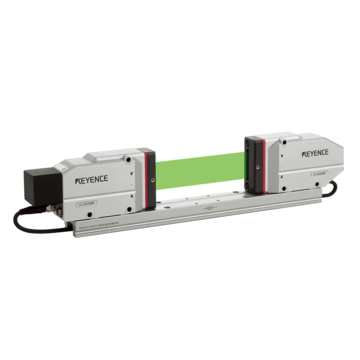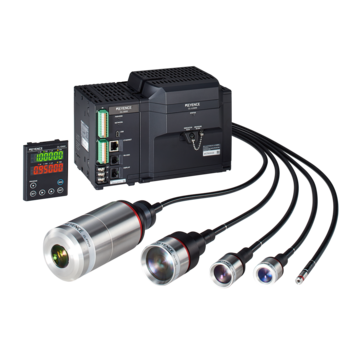Measurement Sensors
- 2D/3D Laser Profiler LJ-X8000 series
- High-speed 2D Laser Profiler LJ-V7000 series
- 2D Laser Displacement Sensor LJ-G5000 series
- Confocal Displacement Sensor CL-3000 series
- Ultra High-Speed/High-Accuracy Laser Displacement Sensor LK-G5000 series
- High-Speed, High-Accuracy CCD Laser Displacement Sensor LK-G3000 series
- Image-Based Laser Sensor IX series
- CMOS Multi-Function Analog Laser Sensor IL series
- Telecentric Measurement System TM-X5000 series
- High-speed optical micrometer LS-9000 series
- High-speed 2D Optical Micrometer TM-3000 series
- High-speed, High-accuracy Digital Micrometer LS-7000 series
- Multi-Purpose CCD Laser Micrometer IG series
- Thrubeam Type Laser Detection Sensor IB series
- 3D Interference Measurement Sensor WI-5000 series
- Micro-head Spectral-interference Laser Displacement Meter SI-F series
- Spectral-Interference Wafer Thickness Meter SI-F80R series
- High-speed, High-Accuracy Digital Displacement Inductive Sensor EX-V series
- Inductive Gauging Sensor AS series
- High-accuracy Positioning Sensor EG series
- High-Accuracy Digital Contact Sensor GT2 series
- General Purpose Digital Contact Sensor GT series
Dimension Measurement
Displacement Measurement
- Measurement Sensors for the Medical and Pharmaceutical Industry
- Measurement Sensors for the Fiber Optic/Cable Industry
- Measurement Sensors for the Film and Sheet Industry
- Measurement Sensors for the Electric Vehicle Industry
- Measurement Sensors for the Semiconductor Industry
- Measurement Sensors for the Electronics Systems Industry
- Measurement Sensors for the Food and Beverage Industry
- Measurement Sensors for the Automotive Manufacturing Industry
- Measurement Sensors for the Metal and Steel Industry
Measuring Eccentricity
When looking for the best way to measure eccentricity, there are several important factors to consider, including the type of measurement system and the installation environment. Selecting equipment that doesn't adequately meet your needs can lead to insufficient precision and increased man-hours during production. This site is designed to help users determine the best way to measure eccentricity with confidence.
What Units Are Used for Eccentricity?
When measuring eccentricity of components in manufacturing, it is typical to use standard linear measurement values, such as inch, thou, millimeter, or micron.
Eccentricity Measurement With a Reflective-Type Sensor
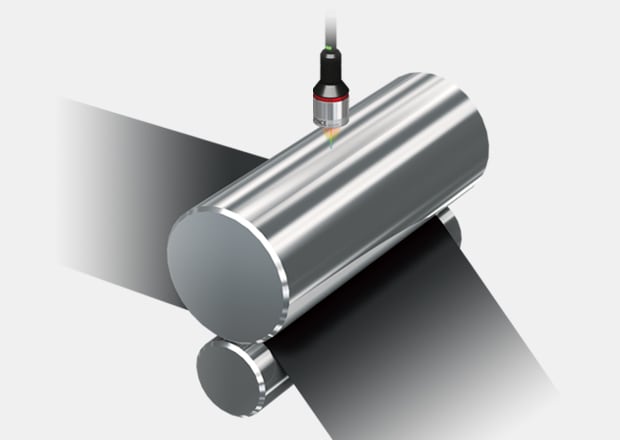
Eccentricity measurement of high-precision rollers
Measuring eccentricity using a reflective-type sensor is a process that involves monitoring the deviation of the shape of an object from an ideal circle or rotation by determining how far the object deviates from its true center. Regardless of the type of sensor you use, the measurment principle remains the same: the scanner will take measurements of various points along the rotation of the object, measure the distance between the surface and the sensor, and build a profile of the surface.
This profile is later analyzed to determine the object's maximum and minimum radii, which indicates eccentricity. Reflective-type sensors offer high precision, which is crucial for applications that require tight tolerances, including aerospace and automotive industries, as well as precision manufacturing. However, not all reflective-type sensors work for all types of surfaces.
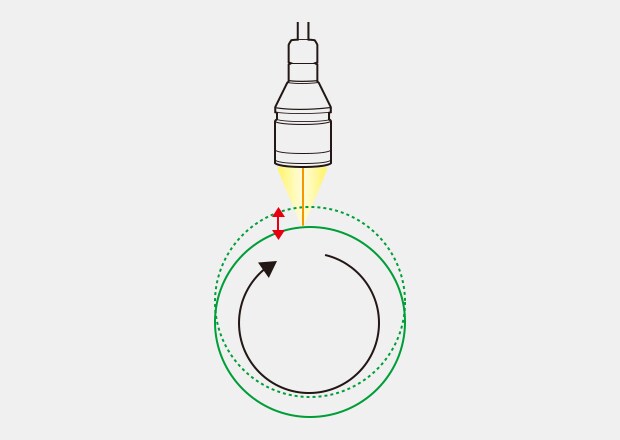
Optimal Measurement System Triangulation Laser Displacement Sensor
The laser is pointed at the apex of the circle to capture fluctuations in distance through high-speed sampling.
- Measurement must be performed at a sampling rate of at least ten times the rotation speed.
- Errors increase as the shaft diameter decreases because the apex position shifts to the left or right due to eccentricity.
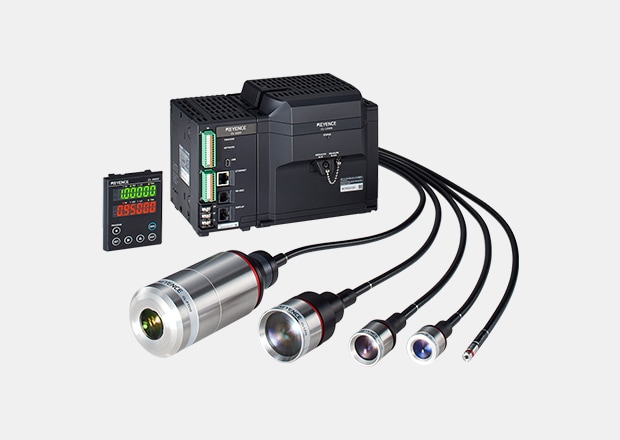
Confocal Displacement Sensor CL-3000 Series
High-precision measurement on all targets, with simple sensor head installation and program settings. CL-3000 Series ultra-compact coaxial laser displacement sensors address manufacturing challenges such as improving quality, preventing the shipment of defective parts and increasing production.
Click here for more details
- Multi-color confocal method
- Linearity: From ±0.2 µm
- Confocal displacement sensor

Micro-head Spectral-interference Laser Displacement Meter SI-F Series
Introducing the world’s first micro-head, with the highest measurement accuracy in its class and a level of performance that was previously thought impossible. These micro-head sensors can be used to measure the thickness and warpage of high-precision objects such as silicon wafers.
Click here for more details
- Spectral interference method
- Ultra-high resolution of 1 nm
- 2 mm microprocessor sensor head
Eccentricity Measurement With a Thrubeam-Type Sensor
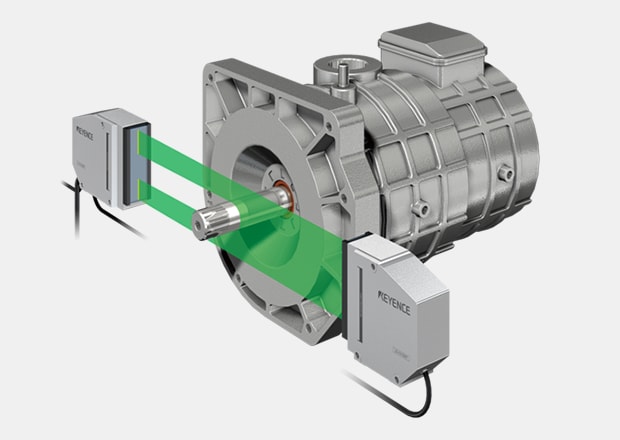
Eccentricity measurement of motor shafts
Thrubeam sensors emit light from a transmitter to a receiver and gather data by measuring any interruptions or shifts in the light due to the presence of an object. Fluctuations in peak-to-peak data can be used to determine eccentricity.
Unlike reflective-type sensors, thrubeam sensors perform stable measurements in environments with heavy vibration and/or product tilt.
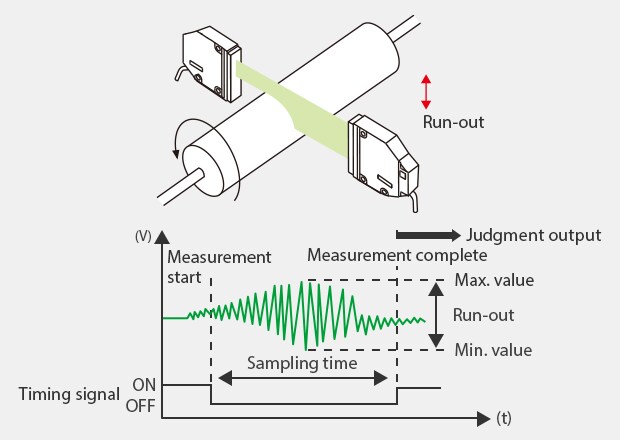
Optimal Measurement System Thrubeam Optical Micrometer
Fluctuations in the edge positions of the roller are captured through high-speed sampling.
- The peak-to-peak value of the run-out is found using a peak-to-peak hold or a similar function.
- Measurement must be performed at a sampling rate of at least ten times the rotation speed.
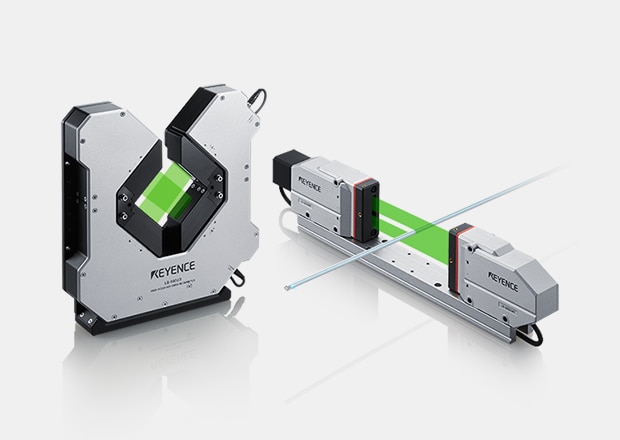
High-speed optical micrometer LS-9000 Series
Accurate eccentricity measurements require sampling speeds of at least 10x the rotation speed of the part. LS-9000 Series optical micrometers have a high sampling speed (16,000 samples/second) and excellent repeatability (±0.03 µm), which makes them a prime choice for these applications.
Click here for more details
- 1D telecentric optical method
- Long service life design that is free of moving parts
- Fastest sampling rate in its class at 16 kHz
Measurement of Eccentricity at Multiple Points With Thrubeam Model
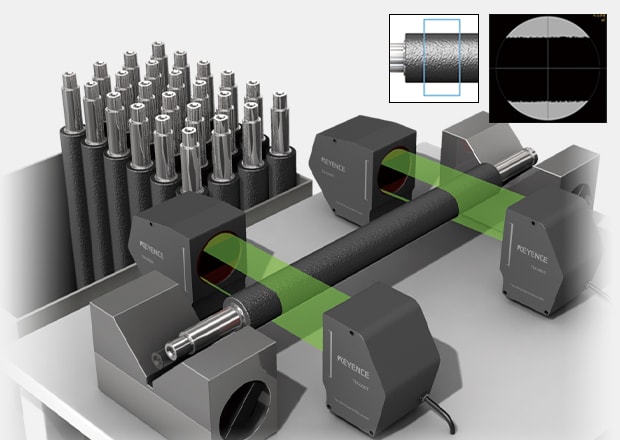
Eccentricity measurement of sponge rollers
Measuring eccentricity using thru-beam type sensors involves passing an object between a measuring system's light emitter and light receiver. The object is typically rotated around its longitudinal axis (which is offset from the geometrical axis) perpendicularly to the light beam.
Depending on the type of sensor you're using to measure eccentricity, the system will either measure the object's shadow, its silhouette, or edge detection in a single line of sight. As the object rotates, the silhouette (or the edge) changes in the receiver's field of vision. These changes are recorded and compiled into a surface profile. The eccentricity measurements are derived from the difference between the maximum and minimum radii detected during rotation.
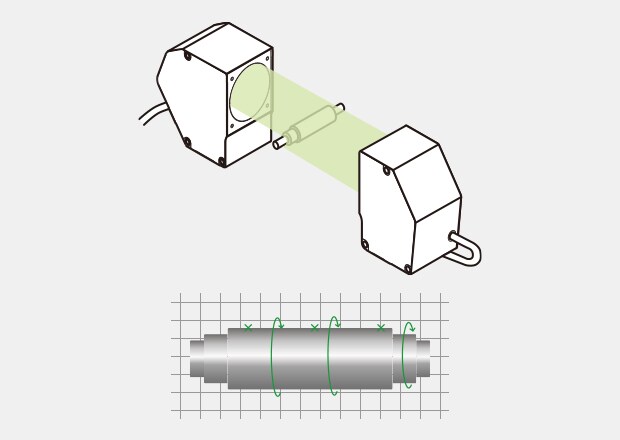
Optimal Measurement System Thrubeam 2D Optical Micrometer
The eccentricity is measured by finding fluctuations at multiple specified point positions using the image obtained by the 2D optical projection method.
- The run-out of V grooves and protrusions in the circumference can be measured.
- The run-out of a point at a predetermined distance from the end can be measured.
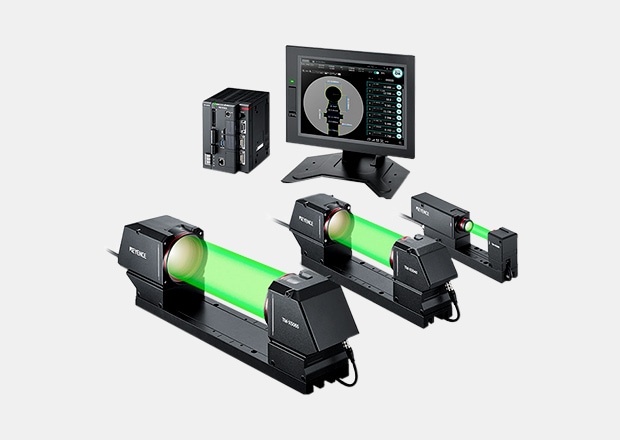
Telecentric Measurement System TM-X5000 Series
TM-X optical micrometers are thrubeam sensors that measure any object that blocks the light passing from the transmitter to the receiver. These sensors are designed without moving parts to provide accurate measurements without regular maintenance.
Click here for more details
2D telecentric optical method. Simultaneous measurement of up to 100 with calibrated high-speed measurement.
What is Eccentricity?
In the context of engineering, component and parts manufacturing, and quality control, eccentricity refers to a deviation from the circular path of rotation. Since the center of rotation is offset from the geometrical center, it's implied that eccentricity is the measure of the non-concentricity of an object's shape or its rotation. The measurement of eccentricity is the distance between the object's theoretical center and the center determined by its physical properties.
In metrology, particularly in quality control, measuring eccentricity is derived from the difference between the largest and the smallest radii measured from the rotational axis to the object's surface. Measuring eccentricity is crucial for all cylindrical parts and components, whether they're eccentric by design or not—if the observed object isn't up to specs, it could cause damage or inefficiency inside the systems they're installed in.
What is Needed to Measure Eccentricity?
Just like with everything else in metrology, precise measurements require precise equipment. However, measuring eccentricity also requires a combination of procedural methodology, depending on the type of sensor and the approach to measurement.
For example, 2D triangulation sensors are capable of determining the distance between the sensor and the surface, which can be used to derive the maximum and minimum radii and quantify eccentricity, and the same applies to multi-color confocal sensors.
Thrubeam-type sensors, while working on an entirely different principle, would still perform the same measurements, but instead of reflecting the light off of an object, they would use the object's shadow or silhouette to quantify eccentricity.
What are Easy Ways to Measure Eccentricity?
Measuring eccentricity in engineering and parts and component manufacturing requires specific and precise measurements. These can be done by hand with relative precision. However, the process is rather tedious, time-consuming, and susceptible to errors and surface damage.
On the other hand, automating the process using non-contact, highly precise measurement systems eliminates nearly all aforementioned concerns, saves time, eliminates error, and doesn't come into contact with the measuring surface.
Related Downloads
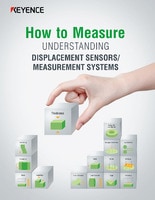
This guide contains a wide range of measurement methods: thickness, width, height/step, outer diameter, stroke, run-out/vibration, eccentricity, warpage/flatness, angle, gap/clearance, target meandering, radius, inner diameter, positioning, profile, and 3D shape.
Related Products
Applications
Dimension Measurement
Displacement Measurement
Profile Measurement
Industries
- Measurement Sensors for the Medical and Pharmaceutical Industry
- Measurement Sensors for the Fiber Optic/Cable Industry
- Measurement Sensors for the Film and Sheet Industry
- Measurement Sensors for the Electric Vehicle Industry
- Measurement Sensors for the Semiconductor Industry
- Measurement Sensors for the Electronics Systems Industry
- Measurement Sensors for the Food and Beverage Industry
- Measurement Sensors for the Automotive Manufacturing Industry
- Measurement Sensors for the Metal and Steel Industry

